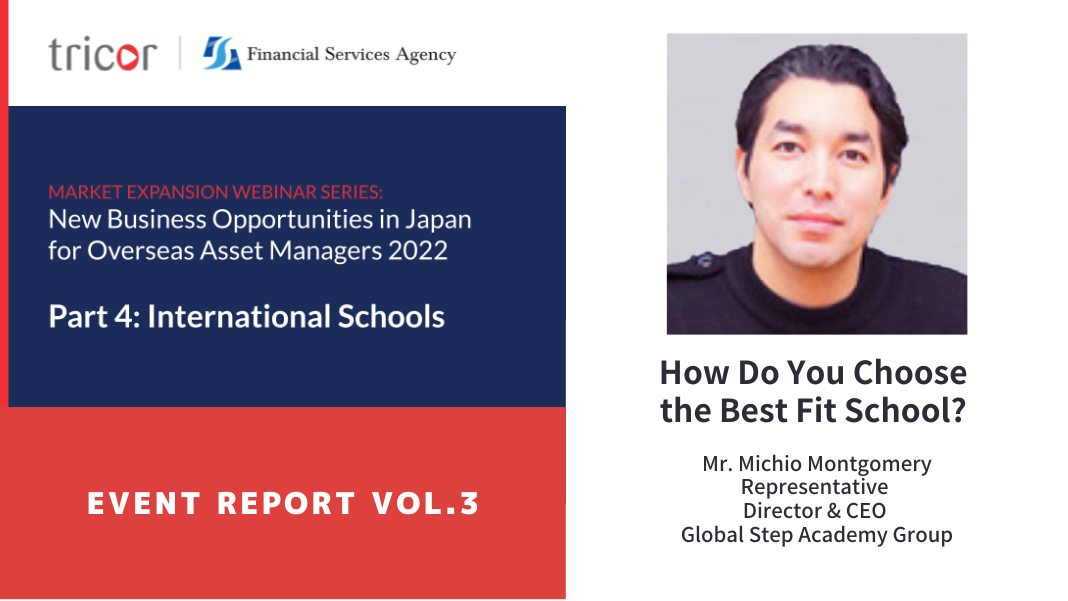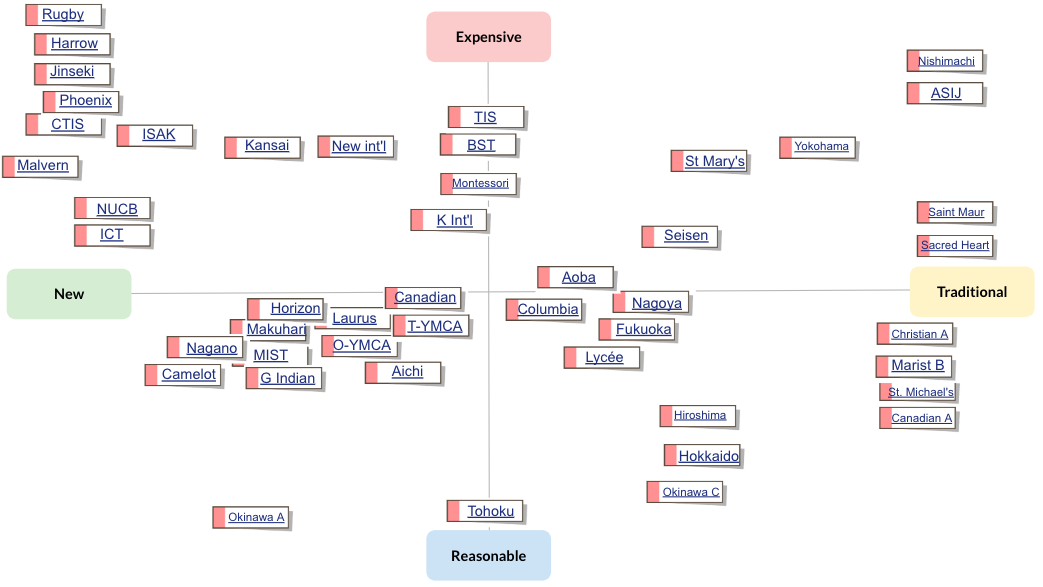How to choose a Best Fit School
Sponsored by FSA and Tricor! The Latest on International schools & Boarding schools
-Event report on a popular international educational event
On Thursday, November 10 and Thursday, November 17, “International schools and Boarding schools Online Seminar” (sponsored by FSA and Tricor) was held. Approximately 570 participants (total for the two days), mainly foreign investors who are considering stationing in Japan and domestic and foreign families interested in international education, listened attentively to the appeal and latest situation of international schools and boarding schools in Japan.
The editorial team will provide a three-part report on the seminar with presentation from the speakers.
In this article, we bring you a presentation by Michio Montogomery, The Representative Director & CEO of Global Step Academy Group, on “How to choose a Best Fit School.”
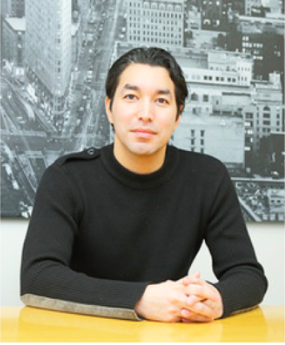 Michio Montgomery
Michio Montgomery
The Representative Director & CEO of Global Step Academy Group
Mr. Montgomery currently is the Representative Director & CEO of Global Step Academy Group, an international education-focused company that provides international education services, both online and offline, for students around the world.
He was also the former Representative Director & CEO of ABC Cooking Studio, the largest cooking school business in Japan and one of the largest in the world. He left after the sale of the company to NTT Docomo in January 2014. Before that, he was an M&A associate at Bank of America Merrill Lynch (BAML). He supported the team in numerous billion-dollar domestic and cross-border M&A deals. He graduated from Babson College with a BA in business administration with a concentration in Entrepreneurship and Economics.
Location and position map of 49 leading schools in Japan
-Location map of 49 leading schools in Japan
Let’s take a general look at what kind of international schools and boarding schools exist in Japan and where they are located.
As you can see, most of the schools are located in the Kanto area, but there are many schools in other major cities in Japan that have excellent programs and interesting and unique visions.
-Position map of 49 leading schools in Japan
This is another angle on the positioning of each of the 49 international schools and boarding schools in Japan. This is not the best way to see the differences between the schools, but it is very simple.
The horizontal axis is the year of establishment, and you can see whether the school is a traditional school or an emerging school. If we look around the new schools on the left side, we can glimpse the recent rush of international schools and boarding schools opening. Characteristically, newer schools need to be more competitive in various aspects, so they have the advantage of having unique curricula and lower-than-average tuition fees.
Next, the vertical axis is a comparison of tuition fees, not only tuition fees, but also the overall necessary expenses such as enrollment fees and facility usage fees. The line right in the middle is the 2 million yen per year line, which includes tuition, facility fees, and other expenses. This is a typical tuition amount for an international school in Japan.
Some of the newer schools that are quite more expensive are Rugby (Chiba), Harrow Appi (Iwate), Jinseki (Hiroshima), and ISAK (Nagano). These are boarding schools in Japan. They are much higher in terms of tuition fees, but they offer vast and wonderful facilities and environments that other international schools cannot offer.
-A list of 49 leading schools
As a support tool to help you choose the best fit school for your child, we have created an updated list of 49 leading schools.
Please use the list to find the best fit school for your child, using the advice from our educational consultants and the school selection process we have described so far.
| Name of School | Boarding / Day | Age range | Girls/ Boys/ Co-ed | Annual Tuition 2022-2023 | Curriculum / Qualification | Year of foundation | Accreditation | Association | University acceptances | Location |
|---|---|---|---|---|---|---|---|---|---|---|
| 1. Saint Maur International School | Day | 2.5-18 | Co-ed | JPY2,230,000 | Montessori,IPC (IPC), IGCSE, IB (DP), AP, Christian | 1872 | CIS, NEASC, IB | JCIS | No disclosure | Yokohama, Kanagawa |
| 2. American school in Japan | Day | 3-18 | Co-ed | JPY2,885,000 | American Curriculum, AP | 1902 | WASC | NAIS, EARCOS, CASE, JCIS, GOA | 2022 | Chofu, Tokyo |
| 3. International School of the Sacred Heart | Day | 3-18 | Girls | JPY2,210,000 | Original, Christian | 1908 | WASC, CIS | EARCOS, AGSA, JCIS, KPASS | 2022 | Shibuya-ku, Tokyo |
| 4. Deutsche Schule Kobe International | Day | 2-11 | Co-ed | No Disclosure | German curriculum, IB (PYP) | 1909 | IB | – | NA | Kobe, Hyogo |
| 5. Canadian Academy | Day & Boarding | 3-18 | Co-ed | JPY1,260,000(D) JPY5,110,000(B) | IB (PYP, MYP, DP) | 1913 | WASC, CIS, IB | JCIS, APAC | 2022 | Kobe, Hyogo |
| 6. Yokohama International School | Day | 3-18 | Co-ed | JPY2,520,000 | IB (PYP, MYP, DP) | 1924 | CIS, NEASC, IB | JCIS | 2022 | Yokohama, Kanagawa |
| 7. St. Michael’s International School | Day | 3-11 | Co-ed | JPY1,397,000 | IPC (IEYC, IPC), Christian | 1946 | WASC, CIS, COBIS, IPC | EARCOS, ICA, JCIS | NA | Kobe, Hyogo |
| 8. Nishimachi International School | Day | 5-15 | Co-ed | JPY2,910,000 | Original | 1949 | WASC, CIS | AAIE, WIDA, EARCOS, ICA, JCIS | NA | Minato-ku, Tokyo |
| 9. Christian Academy in Japan | Day | 5-18 | Co-ed | JPY1,670,000 | American curriculum, Christian | 1950 | WASC, ACSI | EARCOS, CSI, CSPN, JCIS | 2022 | Higashikurume, Tokyo |
| 10. Marist Brothers International School | Day | 3-18 | Co-ed | JPY1,556,500 | Montessori, American Curriculum, IB (DP) | 1951 | WASC, IB | EARCOS, JCIS | 2022 | Kobe, Hyogo |
| 11. St Mary’s International School | Day | 5-18 | Boys | JPY2,480,000 | Original, IB (DP), Christian | 1954 | WASC, CIS, IB | EARCOS, JCIS | 2022 | Setagaya-ku, Tokyo |
| 12. Okinawa Christian School International | Day | 3-18 | Co-ed | JPY868,000 | American curriculum, Christian | 1957 | WASC, ACSI | EARCOS, JEMA, CSPN, NASSP, JCIS, NCAA | 2022 | Yomitan, Okinawa |
| 13.Hokkaido International School | Day | 3-18 | Co-ed | JPY1,101,000 | Reggio Emilia, IPC (IPC, IMYC), CPC, AP | 1958 | WASC, IPC | WIDA, EARCOS, JCIS | 2022 | Sapporo, Hokkaido |
| 14.Seisen International School | Day | 2-18 | Girls | JPY2,130,000 | Montessori, IB (PYP, MYP, DP), Christian | 1962 | CIS, NEASC, IB | JCIS | 2022 | Setagaya-ku, Tokyo |
| 15.Hiroshima International School | Day | 3-18 | Co-ed | JPY1,220,000 | IB (PYP, MYP, DP) | 1962 | CIS, IB | JCIS | 2022 | Asakita-ku, Hiroshima |
| 16. Nagoya International School | Day | 3-18 | Co-ed | JPY1,890,000 | IB (PYP, MYP, DP) | 1964 | WASC, CIS, IB | JCIS | 2022 | Nagoya, Aichi |
| 17. Tohoku International School | Day | 4-18 | Co-ed | JPY693,000 | IB (PYP, MYP, DP), Original | 1970 | WASC, IB | EARCOS, JCIS | 2022 | Sendai, Miyagi |
| 18. Fukuoka International School | Day | 3-18 | Co-ed | JPY1,539,800 | IB (PYP, MYP, DP) | 1972 | WASC, CIS, IB | EARCOS, WIDA, NWEA, JCIS | 2022 | Sawara-ku, Fukuoka |
| 19. Lycée Français International de Tokyo | Day | 3-18 | Co-ed | JPY1,462,887 | French Curriculum, OIB | 1975 | AEFE | – | No disclosure | Kita-ku, Tokyo |
| 20. Aoba Japan International School | Day | 1.6-18 | Co-ed | JPY1,966,500 | IB (PYP, MYP, DP), Original | 1976 | CIS, NEASC, IB | EARCOS, JCIS | 2022 | Meguro-ku, Bunkyo-ku, Tokyo |
| 21. Columbia International School | Day | 4-18 | Co-ed | JPY1,624,500 | Canadian Curriculum | 1988 | WASC | JCIS, ASCD | 2022 | Tokorozawa, Saitama |
| 22. British school in Tokyo | Day | 3-18 | Co-ed | JPY2,625,000 | British Curriculum (GCSE, A-Levels) | 1989 | COBIS | FOBISIA, JCIS | 2022 | Minato-ku, Setagaya-ku, Tokyo |
| 23. Tokyo International School | Day | 5-15 | Co-ed | JPY2,730,000 | IB (PYP, MYP) | 1994 | CIS, NEASC, IB | EARCOS, JCIS | NA | Minato-ku, Tokyo |
| 24. K International School | Day | 3-18 | Co-ed | JPY2,302,000 | IB (PYP, MYP, DP), IGCSE | 1997 | CIS, IB, Cambridge | EARCOS, JCIS, PTC | 2022 | Koto-ku, Tokyo |
| 25. Tokyo YMCA International School | Day | 5-15 | Co-ed | JPY1,844,700 | American Curriculum | 1998 | WASC | – | NA | Koto-ku, Tokyo |
| 26. Canadian International School | Day | 3-18 | Co-ed | JPY1,850,000 | IB (PYP), Canadian Curriculum, AP | 1999 | WASC, IB, PEI | – | 2022 | Shinagawa-ku,Meguro-ku, Tokyo |
| 27. Kinder Kids | Day | 0-6 | Co-ed | No disclosure | Original | 2000 | – | – | NA | Tokyo,Kanagawa,Aichi,Kyoto, Nara,Osaka,Hyogo, Fukuoka |
| 28. New International School | Day | 3-18 | Co-ed | JPY2,450,000 | Original, Multiage Education | 2001 | CIS, MSA | JCIS, PEN | No disclosure | Toshima-ku, Tokyo |
| 29. Laurus International School of Science | Day | 1.5-12 | Co-ed | JPY1,755,000 | Cambridge (CP, CLS), Original | 2001 | Cambridge | – | NA | Minato-ku, Tokyo |
| 30. Osaka YMCA International School | Day | 3-18 | Co-ed | JPY1,248,000 | IB (PYP, MYP, DP) | 2001 | WASC, IB | EARCOS, ECIS, WIDA, JCIS | No disclosure | Kita-ku, Nishi-ku, Osaka |
| 31. Kansai International Academy | Day | 0-18 | Co-ed | JPY2,550,500 | IB (PYP, DP), Original | 2001 | CIS, IB | – | No disclosure | Kobe, Hyogo |
| 32. Musashi International School | Day | 2-18 | Co-ed | JPY1,337,000 | Cambridge (CP, CLS, IGCSE, A-Levels) | 2002 | Cambridge | – | No disclosure | Mitaka, Tokyo |
| 33. Global Indian International School | Day | 2.5-16 | Co-ed | JPY1,186,892 | Montessori, IB (PYP, DP), CBSE, Cambridge (CLS, IGCSE) | 2002 | IB, Cambridge, CBSE | GSF | NA | Edogawa-ku, Tokyo |
| 34. The Montessori School of Tokyo | Day | 2-15 | Co-ed | JPY2,410,000 | Montessori | 2003 | IMC | AMI, JCIS | NA | Minato-ku, Tokyo |
| 35. Horizon Japan International School | Day | 3-18 | Co-ed | JPY1,800,000 | IB (PYP, MYP, DP), American Curriculum | 2003 | WASC, CIS, IB | ECIS | 2022 | Yokohama, Kanagawa |
| 36. Aichi International School | Day | 3-12 | Co-ed | JPY1,234,200 | Japanese Curriculum, Canadian Curriculum | 2006 | WASC, MEXT | – | NA | Nagoya, Aichi |
| 37. Makuhari International School | Day | 3-12 | Co-ed | JPY1,600,000 | Japanese Curriculum | 2006 | CIS, MEXT | EARCOS | NA | Narashino, Chiba |
| 38. Okinawa Amicus International School | Day | 3-15 | Co-ed | JPY702,000 | Original | 2011 | – | Round Square | NA | Uruma, Okinawa |
| 39. International School of Nagano | Day | 0-15 | Co-ed | JPY1,372,000 | IB (PYP) | 2013 | IB | – | NA | Matsumoto,Nagano,Ueda, Nagano |
| 40. UWC ISAK Japan | Boarding | 16-18 | Co-ed | JPY5,282,000 | IB (DP) | 2014 | IB, MEXT | UWC | 2022 | Karuizawa, Nagano |
| 41. Camelot International School | Day | 6-18 | Co-ed | JPY1,170,000 | Cambridge (CP, CLS, IGCSE, A-Levels) | 2014 | Cambridge | – | No disclosure | Itabashi-ku, Tokyo |
| 42. International College of Technology | Boarding | 15-20 | Co-ed | JPY3,250,000 | Japanese Curriculum (MEXT KOSEN) | 2018 | MEXT | – | 2022 | Kanazawa, Ishikawa |
| 43. Jinseki International School | Boarding | 5-12 | Co-ed | JPY7,340,000 | IPC (IPC), MEXT | 2020 | IPC, MEXT | – | NA | Jinseki, Hiroshima |
| 44. NUCB International College | Boarding | 16-18 | Co-ed | JPY3,500,000 | IB (DP), MEXT | 2021 | MEXT | BSA, ABSA | NA | Nisshin, Aichi |
| 45. Phoenix House International School | Day | 5-11 | Co-ed | JPY2,890,000 | British Curriculum | 2021 | – | – | NA | Chiyoda-ku, Tokyo |
| 46. Phoenix House International School | Day | 6-12 | Co-ed | JPY2,772,000 | IB (PYP) | 2022 | – | – | NA | Minato-ku, Tokyo |
| 47. Harrow International School Appi | Day | 11-18 | Co-ed | JPY8,490,000 | British Curriculum (IGCSE, A-Levels) | 2022 | – | – | NA | Appi Kogen, Iwate |
| 48. Rugby School Japan | Day | 11-18 | Co-ed | JPY5,000,000 | British Curriculum (IGCSE, A-Levels) | 2023 | – | – | NA | Kashiwanoha, Chiba |
| 49. Malvern College Tokyo | Day | 5-13 | Co-ed | JPY2,500,000 | IB (PYP, MYP) | 2023 | – | – | NA | Kodaira, Tokyo |
*Criteria for selection: Overall evaluation of accreditation status obtained from international accreditation bodies, as well as the quality and history of the facility.
*Schools that declined to be listed when contacted in advance by the editorial staff will not be listed.
How can we enroll?
-Steps to Admission to international schools and boarding schools
When considering an international school or boarding school, the basic process is as follows.
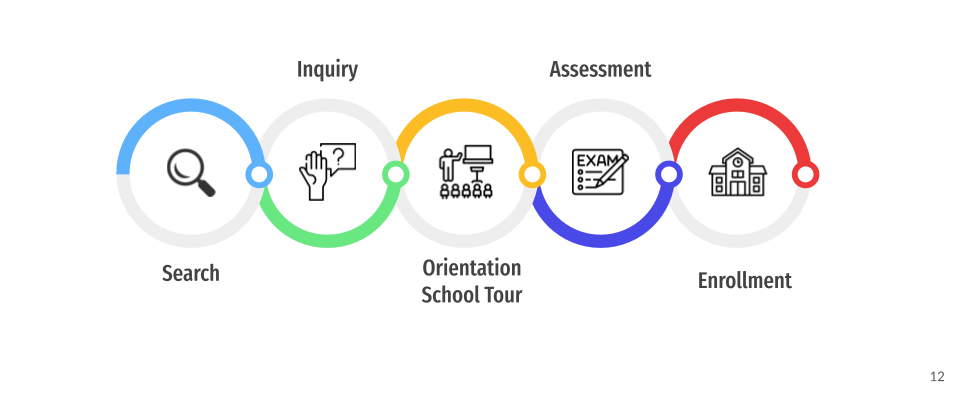 First, search the Internet and make a list of schools you are interested in. Once you have made your list, contact each school to check availability for the grade level you are interested in. Then, adjust your schedule and go to the school that interests you for an orientation and school tour.
First, search the Internet and make a list of schools you are interested in. Once you have made your list, contact each school to check availability for the grade level you are interested in. Then, adjust your schedule and go to the school that interests you for an orientation and school tour.
Once you actually go to the school and attend the orientation and tour, ask the school questions about the points you are interested in.
The school will then screen your child and family, depending on which grade level you wish to place your child in, whether it is Kindergarten or Elementary. The screening process may vary from school to school, depending on which grade level you wish to place your child in. The older your child is, the more different the transfer process will be.
For example, the school may ask a lot of questions about your child’s English level to make sure he or she can keep up in class, and they may also ask about your child’s ability in other subjects, especially math, and his or her grades from previous schools.
Then, if you are fortunate enough to be accepted, you will complete the enrollment process. This is the basic step for choosing an international school or a boarding school.
What should I pay attention to when searching for a school?
-What to look for when searching for a school
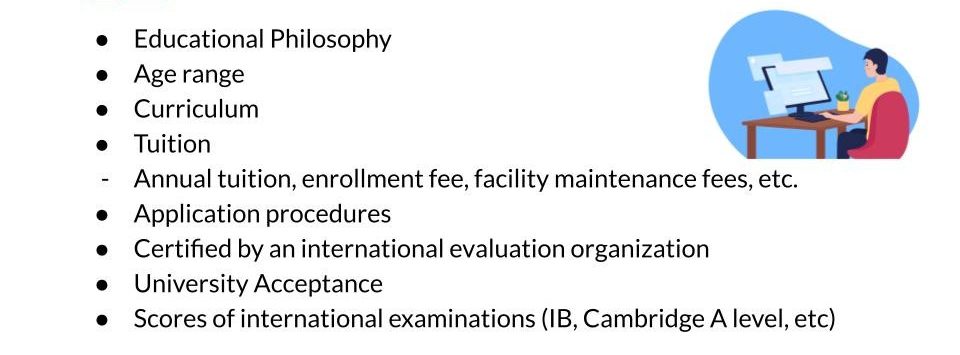 When searching for a school, there are some obvious but very important factors to consider. Such items are summarized above.
When searching for a school, there are some obvious but very important factors to consider. Such items are summarized above.
At the top of the list is educational philosophy. Of course, international schools tend to have very strong philosophies about their ultimate goals. Their vision is in what kind of curriculum they offer and what kind of team they assemble.
Some schools are not perfect consolidators. They may focus on some grade level. Some schools may only open Elementary or High School, while others may only offer Kinder through 9th grade.
Regarding the application process, you should also find out what documents you need to prepare and by when, as well as when you will be admitted (April, September, or some other different time).
Also, several international schools may have curricula that are not competitive from an international perspective if you want to go to an overseas university. Be careful and look at what international accreditations they have. Are the curricula being used in an effective way, and is the school operating at a professional level?
And a very important factor is to visit and observe the school in person. Talk to the principal, teachers, and staff, observe the students, their performance, and the conversations they have with each other.
And the ratio of nationalities. Many international schools, especially in Japan, have basically a majority of Japanese students and may lack international and racial diversity.
Even if they adopt an international curriculum and use English as the language of instruction, depending on the nationality of the students, they may not be exposed to the international quality and cultural diversity that they are looking for. In addition, the nationality bias of the student body may also change the school’s operations.
-What to look for when visiting a school
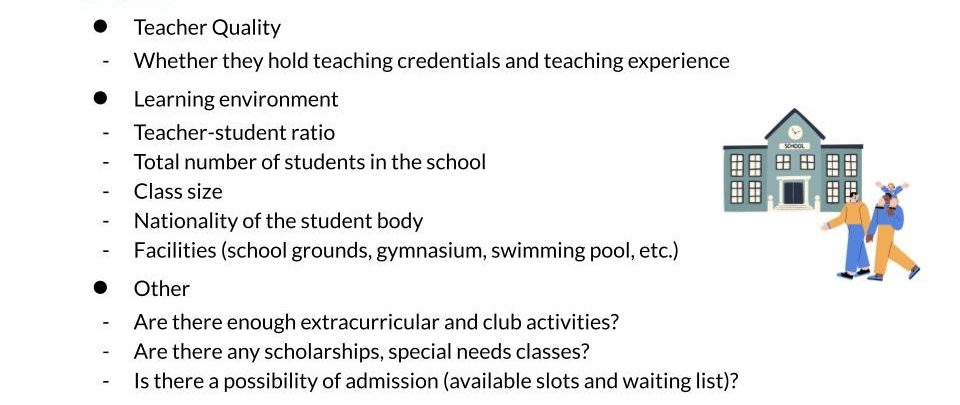 By actually visiting a school and learning about the students, how they interact with each other, the thought process of the teachers, and the educational philosophy, you will learn more about the true value of a school than you can get from a website or a list alone.
By actually visiting a school and learning about the students, how they interact with each other, the thought process of the teachers, and the educational philosophy, you will learn more about the true value of a school than you can get from a website or a list alone.
I believe that the core of a school’s quality consists of “how well the teachers are able to teach their classes” and “whether the teachers and staff work together and truly believe in the philosophy the school offers.” These not only directly affect a child’s development, but also the operation of the school.
As for the learning environment and teacher-student ratios, some schools do not disclose this and tend not to ensure transparency. Talk to parents or alumni who actually send their children to that school to get more real information.
The total number of students in a school is just as important as the class size. You need to know if the environment is one where students have access to teachers or can communicate with teachers and focus more.
At junior high and especially high school, sports and other extracurricular activities become more important to adolescence as they balance their academic activities with opportunities to develop personal interest, experience leadership opportunities, and enjoy being members of a group. Many of these opportunities and offerings may differ depending on what sort of facilities the school may have.
I have experienced two international schools, and the school located in the center of Tokyo clearly had some facility limitations. On the other hand, the school located in the suburbs had more facilities and offered a vast range of opportunities.
Extracurricular activities and clubs are also important. Some schools offer more opportunities than others. They may focus more on specific areas you might be interested in. For example, STEAM education is very popular these days, so some schools will tend to focus on offering programs that are geared heavily towards STEAM education.
Depending on your family situation, you may need to check for scholarships, special needs classes, and, of course, how long the wait list (waiting list) is for possible enrollment slots. Some schools are very popular and space is limited.
If you are looking for an intermediary in Japan, communicating with and getting support from an educational consultant can help you get information that is difficult to find on websites or in public, and may help you in the process.
Gaining International Competitiveness through the Understanding of the Japanese language and culture
-What is the appeal of international schools and boarding schools in Japan?
The appeal of international schools and boarding schools in Japan is the exposure to the Japanese environment and culture.
From an economic standpoint, the Japanese language and culture is of great value, especially in the Asian market, and it is also beneficial from an international market standpoint. The opportunity to learn and grow in a bilingual, bicultural learning environment in Japan, within the Japanese community, is a very interesting factor.
In addition, Japan is currently undergoing a major change in its education system, as Japan’s mid-long term competitiveness is being challenged globally, and the importance of international education is becoming better understood. I believe that this will escalate considerably, especially in the next 5 to 10 years and believe that international education is becoming more important than ever before. So I think we are going to be seeing a lot more positive changes around the international education system in Japan, which will be initiated by the government and the community, ultimately providing educational support, benefits and opportunities to the students growing up in the international school system.
◉Appendix: advice from educational consultants
-Advise from 6 educational consultants
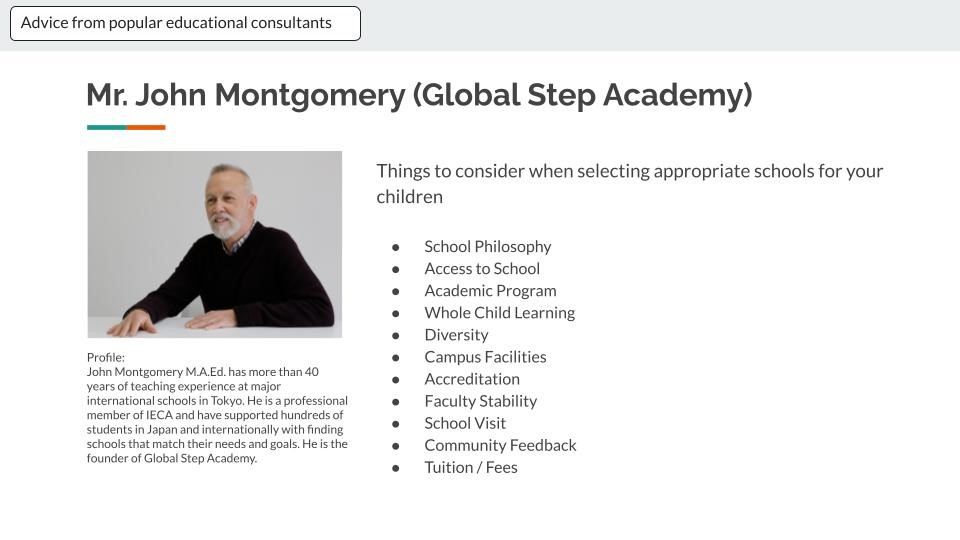
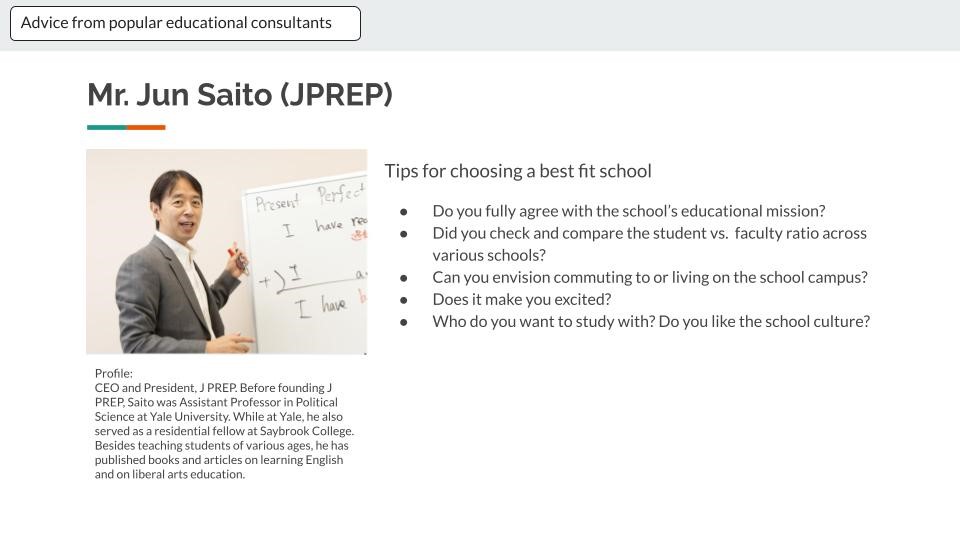
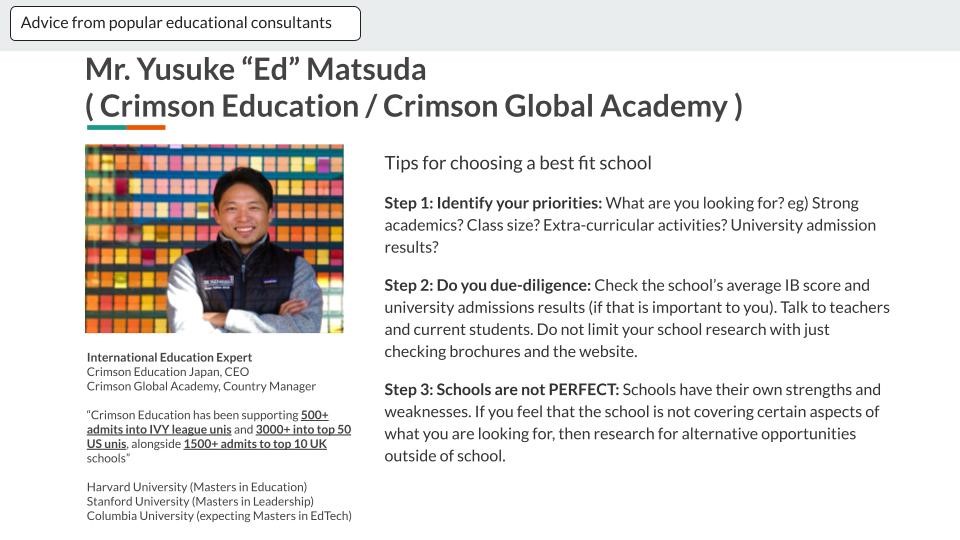
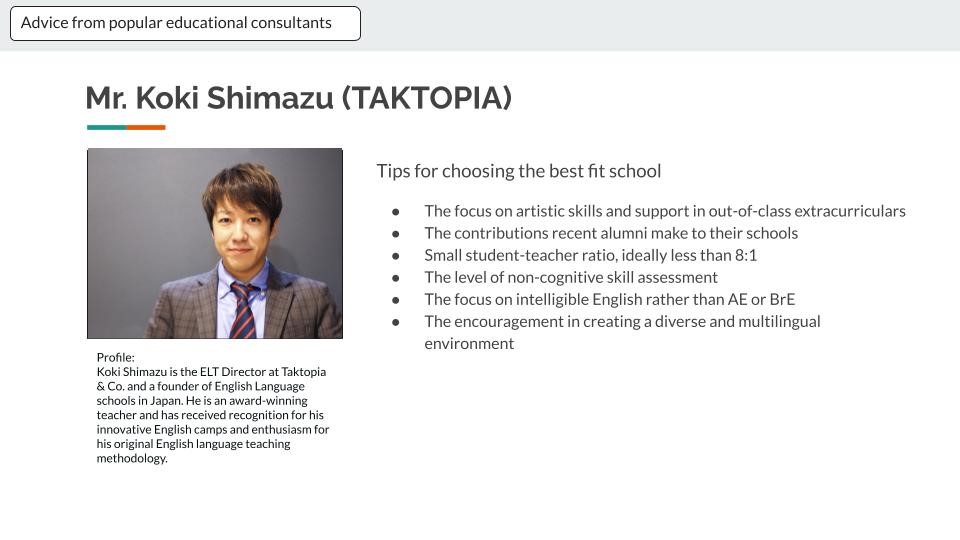
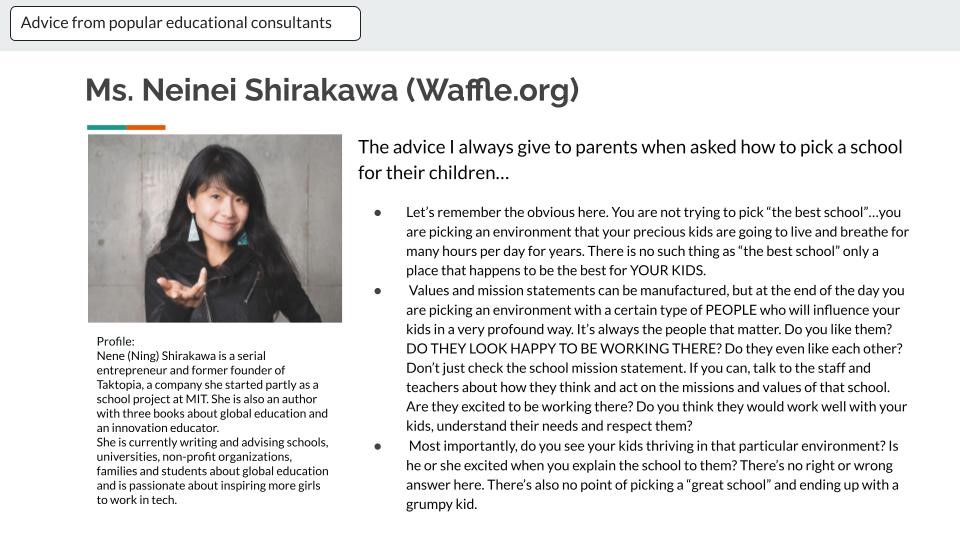

Writer: Kaori Takahashi

